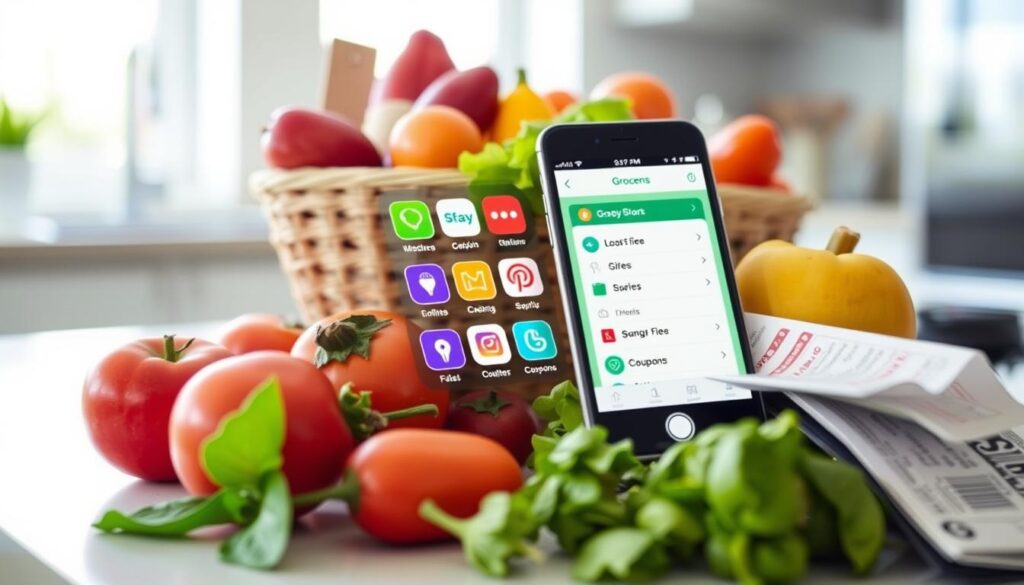Grocery prices have gone up by 22.5% in the last four years. The average family spends over 10% of their income on food, which is over $6,000 a year. To save money, you need to know how to cut down on grocery bills.
Many people are looking for ways to save money without losing quality. Simple tips and hacks can help you save a lot on groceries. Try shopping in season, buying generic items, and using apps like Ibotta and Target Circle.
Changing your dinner plans and buying items on sale can also save you a lot. With the right strategy, you can cut your grocery bill by 50 to 60%. This article will show you how to save money on groceries each month.
Table of Contents
Key Takeaways
- Average families spend over $6,000 a year on groceries, which is around 10% of their household income.
- Grocery prices have increased by 22.5% over the past four years, making it essential to save money on groceries.
- Shopping in season, buying generic staples, and using coupon apps can help reduce your grocery bills.
- Planning meals around items on sale and using coupons can lead to savings of up to 50 to 60% off your grocery bill.
- Implementing a well-crafted weekly meal plan can save you 2 to 4 hours per week and $100 to $200+ per month.
- Having a well-organized grocery list can save you time and money, with estimated monthly savings of approximately $150.
Understanding the Basics of Smart Grocery Shopping
Smart grocery shopping helps lower grocery bills and enhances your shopping experience. Knowing how supermarket layouts work is key. This knowledge helps you make better choices and avoid spending too much.
Grocery prices have gone up by 22.5% in four years. To save money, plan your meals and make a list before you shop. This way, you can avoid buying things on impulse and stay within your budget.
Why Grocery Bills Keep Increasing
Many things cause grocery bills to go up, like inflation and marketing. Here are some tips to help you save:
- Buy seasonal produce to reduce costs
- Opt for generic or store-brand items
- Compare prices between stores and online retailers
The Psychology of Supermarket Layouts
Supermarket layouts are made to make you spend more. The most expensive items are often at eye level. Cheaper items are on top or bottom shelves. Knowing this can help you save money.
| Shopping Strategy | Benefits |
|---|---|
| Meal planning | Reduces food waste and saves money |
| Shopping lists | Helps stick to budget and avoid impulse purchases |
| Comparing prices | Ensures you get the best value for your money |
By learning about smart grocery shopping and supermarket layouts, you can make better choices. Plan your meals, make a list, and compare prices. This way, you’ll save money and enjoy your shopping more.
Create a Strategic Meal Planning System
Meal planning is key to saving on groceries. It stops last-minute takeouts and cuts down on food waste. Strategic planning lets you list what you need and stick to it, avoiding extra costs. This way, you cook healthier meals and save time.
Having a good meal plan can save a lot of money. For example, one trip to the store with a list can save $125 to $150. Effective planning also means planning for leftovers, which saves money and reduces waste.
Meal planning has many benefits:
- It reduces food waste by using what you already have.
- It saves time by cooking extra for leftovers.
- It lets family members cook on their own.
- It promotes healthier eating.
Adding grocery shopping to your meal plan can save on gas. Shopping mostly at one store, like Aldi, is a good idea. Meal planning apps can help find recipes, make lists, and track calories. With some strategic planning, you can make a meal plan that’s good for your family. It makes grocery shopping and meal prep more efficient and affordable.
The Power of Shopping Lists and Budgets
Creating a shopping list and setting a realistic grocery budget are key steps to save on groceries. A list helps you avoid buying things you don’t need. Budget tracking apps can also keep you on track with your spending.
Some benefits of using shopping lists and budgets include:
- Reduced impulse purchases
- Better tracking of spending
- Easier meal planning
Using budget tracking apps can also show you where to cut costs. Being mindful of your spending can lead to big savings. With a few simple changes, you can manage your grocery budget better.
The average American household spends $475.25 monthly on groceries. It’s crucial to have a plan to save money. By using shopping lists, setting budgets, and tracking your spending, you can control your grocery costs and improve your finances.
| Category | Average Monthly Spending |
|---|---|
| Groceries | $475.25 |
Best Times to Save Money on Groceries
Timing is key when it comes to grocery shopping. Knowing when to shop can save you money. For example, buying during sales or using coupons can cut down your grocery costs. Over the last four years, grocery prices have gone up by 22.5%, making smart shopping even more crucial.
To get the most out of your grocery shopping, try these tips:
- Shop during weekly sales to take advantage of discounted prices
- Use coupons to reduce your bills
- Buy in bulk, but compare the price per unit or ounce to ensure you’re getting a good deal
- Shop in season for produce to reduce costs
By knowing the best times to shop and using these tips, you can make smarter choices. This way, you can save money on your groceries. Remember, saving money on groceries is all about being strategic and planning ahead. With a bit of practice, you can find the best deals and lower your grocery bills.
| Shopping Strategy | Potential Savings |
|---|---|
| Shopping during sales | 10-20% |
| Using coupons | 5-15% |
| Buying in bulk | 5-10% |
Maximizing Store Loyalty Programs and Rewards
Store loyalty programs and rewards can save you money on groceries. Digital coupons and cashback apps help you earn discounts. Many grocery stores give discounts, points, or special deals to their members.
Cashback apps like Ibotta and Rakuten give cash back for grocery buys. Credit cards, such as the Blue Cash Preferred Card from American Express, also offer rewards for grocery shopping.
To save more, stack rewards from different sources. This means combining digital coupons with loyalty points or using a cashback app with a rewards credit card. This way, you can cut down your grocery bills and stay on budget.
Here are some tips for using store loyalty programs and rewards:
- Always read the terms and conditions of each program to understand how to earn and redeem rewards.
- Keep track of your loyalty program points and rewards to ensure you don’t miss out on any savings opportunities.
- Consider using a rewards credit card for your grocery purchases to earn additional points or cash back.
Bulk Buying Strategies That Actually Work
Buying in bulk can save you money on grocery shopping. But, you need a good plan to make it work. Focus on items you use often and store them well to avoid waste. Good bulk buys include paper towels, toilet paper, toothpaste, shampoo, and non-perishable foods.
It’s important to compare unit prices to see if buying more saves you money. Places like Costco, Sam’s Club, and BJ’s Wholesale are great for bulk shopping. They often need a membership. Online stores like Amazon and Boxed also offer bulk deals, but watch for shipping minimums.
Buying in bulk can save you time and gas. It also means you spend less money. For example, a 3-pound bag of apples for $3 saves 76% compared to buying single apples. By using bulk buying in your grocery shopping and smart strategies, you can cut down on expenses.
| Item | Bulk Price | Unit Price | Savings |
|---|---|---|---|
| Apples (3-pound bag) | $3 | $0.25 per pound | 76% |
| Toilet Paper (24-pack) | $15 | $0.62 per roll | 40% |
| Shampoo (1-gallon bottle) | $20 | $1.25 per ounce | 50% |
Being smart about bulk buying can lead to big savings on grocery shopping. Always check unit prices and think about storage. Plan your buys well to maximize your bulk shopping benefits.
Smart Ways to Use Your Freezer
Using your freezer can save you money by reducing food waste. It lets you buy items in bulk. When you plan ahead and use your freezer wisely, you can save a lot.
Some foods freeze well, but others might not. Knowing what can be frozen and for how long is key. Here are some guidelines for common foods:
- Meat: 3-6 months
- Fish and seafood: 1-3 months
- Dairy: 1-6 months
- Vegetables: 6-10 months
- Fruit: 4-10 months
Using airtight containers or freezer bags helps keep food quality. Labeling and rotating frozen items prevents waste. This makes meal prep simpler and saves money on grocery shopping.
Batch cooking meals can cut costs and simplify meal planning. Freezers are great for batch cooking and buying in bulk. Being smart about freezer use can lead to big savings on grocery shopping.
| Food | Freezer Life |
|---|---|
| Ground sausage | 3 months |
| Chicken breasts | 3 months |
| Cheese | 3-6 months |
Generic vs. Name Brand: Making the Right Choice
Choosing between generic and name brand items is crucial when grocery shopping. Food prices have gone up by nearly 9% each year. This makes picking the right option key to saving money.
Recent data shows a big jump in generic brand purchases, up 11.4% in 2020. These products are often 20% to 25% cheaper than name brands.
Items like milk, juice, and spices are often cheaper as generic brands. For example, Kroger’s Private Selection tomato sauce costs $2.49, 20 cents less than the name-brand sauce at $2.69. Many stores also offer generic organic options, like Simple Truth at Kroger or GreenWise at Publix.
Here are some benefits of choosing generic over name brand:
- Lower prices: Store brand products are usually 20% to 25% lower in price compared to name brands.
- Similar quality: 75% of consumers believe store brands are of the same quality as major national brands.
- Increased savings: Generic products for three dinner recipes could save over $11 a week, about $44 a month, or $528 a year.
By choosing generic or store-brand items, you can save money on grocery shopping. This lets you spend that money on other important things. With food prices expected to rise by 7.5% in 2023, making smart choices is more crucial than ever.
Seasonal Shopping for Better Deals
Understanding produce seasons can save you money and help you make better choices. Shopping in season means lower prices on fresh produce, meats, and more. For instance, January is perfect for buying low-calorie frozen meals and healthy packaged foods. February brings discounts on canned goods, thanks to National Canned Food Month.
Throughout the year, different items go on sale. Seasonal produce comes from closer locations, leading to better prices and sales. Some top months for specific items include:
- April: Ham and chocolates after Easter
- May: Ground beef and Memorial Day discounts on meats
- November: Clearance Halloween candy and Thanksgiving-related food sales
Frozen fruits and veggies from trusted brands are great for out-of-season produce. They keep nutrients and freshness. Local farmers offer seasonal products like eggs, maple syrup, honey, and meat. This supports the community and ensures you eat seasonally.
Shopping in season helps you plan meals with the freshest ingredients. Take advantage of holiday sales and clearance events to save on non-perishable items. With some planning, you can enjoy fresh, healthy, and affordable food all year.
| Month | Items on Sale |
|---|---|
| January | Low-calorie frozen meals, packaged healthy foods |
| February | Canned goods, soups, beans, meats |
| March | Frozen items, snack foods |
How to Compare Prices Effectively
When you’re grocery shopping, it’s key to compare prices to save money. By doing an effective comparison, you can make smart choices and not spend too much. Use price comparison tools and apps to see prices at different stores and brands.
Here are some tips for effective comparison:
- Look for sales and discounts on items you regularly buy
- Compare prices across different stores and brands
- Use price comparison tools and apps to make it easier
By following these tips, you can make grocery shopping more efficient and cost-effective. Always watch prices and find ways to save money through price comparison.
Also, since household budgets are wasted on food that ends up in the trash, it’s vital to plan your grocery shopping well. Make an effective comparison to avoid waste and save money.
| Shopping Strategy | Benefits |
|---|---|
| Bulk buying | Cost-effective for items with long shelf life |
| Shopping seasonally | Cheaper and fresher produce |
| Using coupons and loyalty programs | Discounts and rewards for loyal customers |
Reducing Food Waste to Save Money
Reducing food waste is key to saving money on groceries. By using smart storage and meal planning, you can cut down on waste. In the U.S., people throw away up to 40% of what they buy, costing a lot and harming the environment.
Storing food right and being creative with leftovers can help. Labeling containers helps track what you have and prevents waste. Using leftovers wisely saves you money and reduces waste.
Here are some ways to cut down on food waste:
- Plan your meals and make a shopping list to avoid buying too much.
- Use airtight containers and freezer bags to keep food fresh.
- Buy “ugly” produce for cheaper.
- Compost vegetable scraps to reduce waste and enrich the soil.
By trying these tips, you can save money, reduce waste, and help the planet.
| Strategy | Benefits |
|---|---|
| Meal planning | Reduces food waste, saves money, and promotes healthy eating |
| Proper storage | Extends shelf life of ingredients, reduces spoilage, and saves money |
| Composting | Reduces waste, provides nutrients to soil, and promotes sustainability |
Digital Tools and Apps for Grocery Savings
Using digital tools and apps can really help when you’re grocery shopping. Now, you can get cash back and discounts on what you buy. This is thanks to digital coupons and rebate apps.
Apps like Ibotta and Rakuten give you cash back and discounts on many items. Tools like Flipp and Basket help you find the best prices. They compare prices for you.
Here are some good things about using digital tools and apps for saving money:
- Earn cash back and discounts on grocery purchases
- Compare prices and find the best deals
- Access to digital coupons and rebate offers
- Personalized recommendations based on shopping habits
These digital tools and apps help you make better choices and save money. With the savings from digital coupons and rebate apps, it’s a good idea to try them out next time you shop.
| App | Features | Savings |
|---|---|---|
| Ibotta | Cash back and discounts | Up to 10% cash back |
| Rakuten | Cash back and discounts | Up to 5% cash back |
| Flipp | Price comparison and digital coupons | Up to 50% off |
Alternative Shopping Venues to Consider
Many of us stick to the same grocery stores out of habit. But, exploring new places can save money and introduce new products. Options like farmers markets, discount stores, and wholesale clubs offer fresh produce and lower prices.
Shopping at farmers markets supports local farmers and gets you fresh, seasonal food. Many cities have weekly markets with fruits, veggies, and more. Stores like Aldi and Lidl also offer cheap prices on essentials like canned goods and meat.
Some popular spots include:
- Wholesale clubs like Costco and Sam’s Club, which offer discounted prices on bulk purchases
- Discount grocery stores like Aldi and Lidl, which offer affordable prices on staples
- Farmers markets, which offer fresh, seasonal produce and support local farmers
Exploring these alternatives can cut your grocery costs and find new products. Whether you’re after fresh produce, savings, or a unique shopping trip, these venues are worth a visit.
| Store | Prices | Products |
|---|---|---|
| Aldi | Low | Canned goods, dairy products, meat |
| Lidl | Low | Produce, meat, dairy products |
| Costco | Discounted | Bulk purchases, staples |
Building Long-term Money-Saving Habits
Creating money-saving habits can greatly improve your financial health, especially with grocery shopping. By setting a budget, tracking your spending, and avoiding impulse buys, you make better choices. This leads to long-term savings.
To begin, try strategies like automatic transfers between accounts or savings challenges like the 52-week money challenge. Also, look into employer-matched 401(k) plans or FDIC-insured IRAs for long-term savings.
For grocery shopping on a budget, consider these tips:
- Plan meals and make a shopping list to avoid impulse buys
- Buy in bulk and use coupons to cut costs
- Shop during sales tax holidays or use cashback apps for rewards
By adopting these money-saving habits and watching your spending, you can save a lot over time. This will greatly improve your financial health.
| Strategy | Benefits |
|---|---|
| Automated transfers | Easy and convenient way to save |
| 52-week money challenge | Encourages consistent savings and can help build emergency fund |
| Employer-matched 401(k) plans | Provides opportunity for long-term savings and retirement planning |
Conclusion: Making Your Grocery Savings Last
In conclusion, you can save money on your monthly grocery bills. By using strategies like meal planning and store loyalty programs, you can cut down on spending. This way, you can use that money for other important things.
Saving on groceries is more than just cutting costs. It’s about making smart choices and building lasting habits. By watching your spending, comparing prices, and reducing waste, you can make your grocery budget go further. This way, you can enjoy the benefits of your savings over time.
With grocery prices going up by 22.5% in four years, staying alert is key. By using the strategies from this article, you can manage grocery costs better. This will help you save money and improve your financial health.
FAQ
What are the key strategies for saving money on groceries each month?
To save money, start with a meal plan. Use shopping lists and budgets wisely. Shop during the best times and use store loyalty programs. Also, consider buying in bulk.
How can understanding the basics of smart grocery shopping help save money?
Knowing why grocery bills rise and supermarket layouts can help. It also helps to avoid common shopping mistakes. This way, you can make better choices and save money.
What is the importance of meal planning for saving money on groceries?
Meal planning helps you list what you need and avoid impulse buys. It reduces waste and helps you cook healthier. All these lead to big savings.
How can shopping lists and budgets help save money on groceries?
A good shopping list and budget keep you from buying things you don’t need. They help you stay on track and track your spending with apps.
What are the best times to shop for grocery savings?
Shop during sales, use coupons, and buy in-season produce. These strategies help you find discounts and save money.
How can store loyalty programs and rewards help save money on groceries?
Digital coupons, cashback apps, and store rewards offer discounts. They help you save on regular purchases.
What are the benefits of bulk buying for grocery savings?
Buying in bulk saves money and reduces waste. Just make sure you store items properly and use them before they expire.
How can using your freezer help save money on groceries?
Freezer-friendly foods and proper storage reduce waste and save money. Meal prep and freezing techniques also help.
When is it better to choose generic or store-brand items over name-brand products?
Generic items are often cheaper and just as good. They’re a smart choice for saving money.
How can seasonal shopping help save money on groceries?
Shopping during produce seasons and holiday sales saves money. You get discounts on in-season items.
What are effective ways to compare prices and save money?
Use price comparison tools and apps. They help you make smart choices and avoid overspending.
How can reducing food waste lead to grocery savings?
Proper storage, creative use of leftovers, and knowing expiration dates reduce waste. This saves money on your grocery bills.
What digital tools and apps can help save money on groceries?
Apps like Ibotta and Rakuten offer cash back and discounts. Other tools help compare prices, find coupons, and track spending.
What alternative shopping venues should I consider for grocery savings?
Try farmers markets, discount stores, and wholesale clubs. They offer fresh produce and other items at lower prices than supermarkets.
How can building long-term money-saving habits help with grocery expenses?
Create a budget, track spending, and avoid impulse buys. These habits reduce your need for credit cards and loans, improving your financial health.









